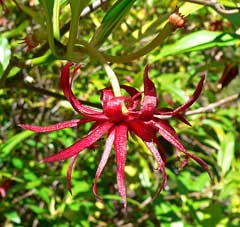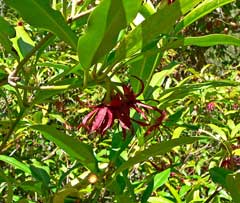 |
|
http://commons.wikimedia.org/wiki/User:Stan_Shebs |
 |
| http://commons.wikimedia.org/wiki/User:Stan_Shebs |
Translate this page:
Summary
Bloom Color: Pink, Purple, Red. Main Bloom Time: Early spring, Late spring, Mid spring. Form: Oval, Rounded.
Physical Characteristics

 Illicium floridanum is an evergreen Shrub growing to 2 m (6ft) by 2 m (6ft) at a slow rate.
Illicium floridanum is an evergreen Shrub growing to 2 m (6ft) by 2 m (6ft) at a slow rate.
See above for USDA hardiness. It is hardy to UK zone 7 and is not frost tender. It is in leaf all year, in flower from May to June, and the seeds ripen in October. The species is hermaphrodite (has both male and female organs) and is pollinated by Insects.
Suitable for: light (sandy) and medium (loamy) soils and prefers well-drained soil. Suitable pH: mildly acid and neutral soils. It can grow in semi-shade (light woodland) or no shade. It prefers moist soil.
UK Hardiness Map
US Hardiness Map
Synonyms
Plant Habitats
Woodland Garden Sunny Edge; Dappled Shade;
Edible Uses
Edible Parts:
Edible Uses: Condiment
Said to be used as a spice[105, 177, 183]. No further details are given, but the leaves have a strong aroma of aniseed[245].
References More on Edible Uses
Medicinal Uses
Plants For A Future can not take any responsibility for any adverse effects from the use of plants. Always seek advice from a professional before using a plant medicinally.
None known
References More on Medicinal Uses
The Bookshop: Edible Plant Books
Our Latest books on Perennial Plants For Food Forests and Permaculture Gardens in paperback or digital formats.

Edible Tropical Plants
Food Forest Plants for Hotter Conditions: 250+ Plants For Tropical Food Forests & Permaculture Gardens.
More

Edible Temperate Plants
Plants for Your Food Forest: 500 Plants for Temperate Food Forests & Permaculture Gardens.
More

More Books
PFAF have eight books available in paperback and digital formats. Browse the shop for more information.
Shop Now
Other Uses
References More on Other Uses
Cultivation details
Landscape Uses:Border, Foundation, Pest tolerant, Massing, Screen, Specimen, Woodland garden. Prefers a light, moist well-drained loam and a sheltered position[1, 11] Prefers a humus-rich lime-free soil[182, 200]. A plant of woodland shade in its native habitat, in the less sunny British climate it succeeds in sun or semi-shade[200, 260]. This species is not very cold-hardy, it tolerates temperatures down to between -5 and -10°c, only succeeding outdoors in the mildest areas of Britain[1, 11, 166]. A slow-growing tree[229], the whole plant is very aromatic[182]. The bruised leaves have a strong scent of aniseed, whilst the flowers have a powerful spicy odour[245]. Suckers can spring up at some distance from the parent plant[260]. Special Features:Attracts birds, Attractive foliage, North American native, Fragrant foliage, Wetlands plant, Suitable for cut flowers, Attractive flowers or blooms. The plant is heat tolerant in zones 9 through 7. (Plant Hardiness Zones show how well plants withstand cold winter temperatures.
Plant Heat Zones show when plants would start suffering from the heat.
The Plant Heat Zone map is based on the number of "heat days" experienced in a given area where the temperature climbs to over 86 degrees F (30°C).
At this temperature, many plants begin to suffer physiological damage. Heat Zones range from 1 (no heat days) to 12 (210 or more heat days).
For example Heat Zone. 11-1 indicates that the plant is heat tolerant in zones 11 through 1.) For polyculture design as well as the above-ground architecture (form - tree, shrub etc. and size shown above) information on the habit and root pattern is also useful and given here if available. An evergreen. A clumping plant, forming a colony from shoots away from the crown but with a limited spread [1-2]. The root pattern is suckering with new plants from underground runners away from the plant [1-2].
References Carbon Farming Information and Carbon Sequestration Information
Temperature Converter
Type a value in the Celsius field to convert the value to Fahrenheit:
Fahrenheit:
The PFAF Bookshop
Plants For A Future have a number of books available in paperback and digital form. Book titles include Edible Plants, Edible Perennials, Edible Trees,Edible Shrubs, Woodland Gardening, and Temperate Food Forest Plants. Our new book is Food Forest Plants For Hotter Conditions (Tropical and Sub-Tropical).
Shop Now
Plant Propagation
Seed - it does not require pre-treatment and can be sown in early spring in a greenhouse[113]. Prick out the seedlings into individual pots when they are large enough to handle and grow them on in the greenhouse for at least their first winter. Plant out in late spring or early summer, after the last expected frosts, and give some protection from the cold over the winter for the first year or two. Layering in early spring. Takes 18 months[78]. Cuttings of half-ripe wood, August in a frame[113]. Pot up the cuttings when they start to root and grow them on in the greenhouse for their first winter, planting out after the last expected frosts. Suckers are sometimes produced at some distance from the parent plant. These suckers can be potted up in early spring, then grown on for a year before planting them out into their permanent positions.
Other Names
If available other names are mentioned here
Native Plant Search
Search over 900 plants ideal for food forests and permaculture gardens. Filter to search native plants to your area. The plants selected are the plants in our book 'Plants For Your Food Forest: 500 Plants for Temperate Food Forests and Permaculture Gardens, as well as plants chosen for our forthcoming related books for Tropical/Hot Wet Climates and Mediterranean/Hot Dry Climates. Native Plant Search
Found In
Countries where the plant has been found are listed here if the information is available
Weed Potential
Right plant wrong place. We are currently updating this section.
Please note that a plant may be invasive in one area but may not in your area so it’s worth checking.
Conservation Status
IUCN Red List of Threatened Plants Status :

Growth: S = slow M = medium F = fast. Soil: L = light (sandy) M = medium H = heavy (clay). pH: A = acid N = neutral B = basic (alkaline). Shade: F = full shade S = semi-shade N = no shade. Moisture: D = dry M = Moist We = wet Wa = water.

Expert comment
Author
J.Ellis.
Botanical References
72200
Links / References
For a list of references used on this page please go here
Readers comment